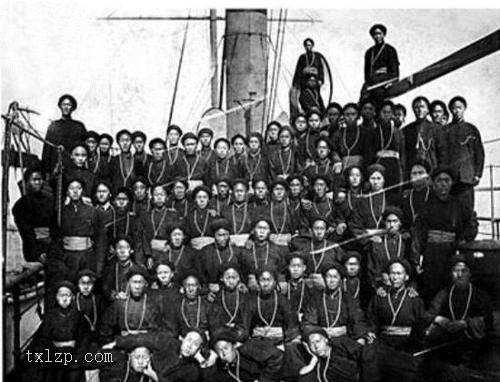Period:Ming dynasty Production date:1500-1600 (circa)
Materials:earthenware
Technique:glazed, moulded, painted, cold painted,
Subjects:bearer
Dimensions:Height: 19.40 centimetres
Description:
Green-glazed earthenware funerary model of a sedan chair bearer. This male figure stands with his right sleeve-covered hands resting on his right shoulder, leaving a gap through which the pole of a model sedan chair would fit. He wears green-glazed robes with long sleeves, crossed over at the neck and secured at the waist with a sash. Much of the glaze has degraded during burial. His tall brimless busby-style hat was once cold-painted black, as were his boots.
IMG
![图片[1]-figure BM-1935-0418.2-China Archive](https://chinaarchive.net/Ming dynasty/43/mid_00273548_001.jpg)
Comments:Harrison-Hall 2001:Made from the same mould as BM 1935.0418.3, these figures would originally have been the same height to ensure smooth transport of the tomb occupant. Old restoration to their legs and feet and a replacement base for the smaller figure mean that they are now different heights. The figures both stood on the same side of the chair.Many sets of servants made from clay or stone have been excavated from Ming tombs. Ming tomb figures are often arranged in processions around a sedan chair, which is shielded on all sides by curtains against the elements and prying eyes. Thus one of the most frequently found types of attendant in these processions is the sedan chair bearer, in groups of either two or four men on either side of the chair, carrying its supporting poles or standing in readiness to pick them up. A stone group of eight model sedan chair bearers was excavated from a tomb belonging to Li Sanxi (1496-1560); and another two sets were unearthed from the burials of Zhang Wenjin (1506-56) and his wife Mme Shen (1498-1577); all were at Tongliang, Sichuan. Such sedan chair bearers were a central part of the model procession. Presumably the deceased was expected to travel about in the chair in the afterlife. As Jessica Rawson has suggested in reference to earlier tomb figures of the Han period, such journeys were regarded as visits rather than as an ultimate progression to paradise.
Materials:earthenware
Technique:glazed, moulded, painted, cold painted,
Subjects:bearer
Dimensions:Height: 19.40 centimetres
Description:
Green-glazed earthenware funerary model of a sedan chair bearer. This male figure stands with his right sleeve-covered hands resting on his right shoulder, leaving a gap through which the pole of a model sedan chair would fit. He wears green-glazed robes with long sleeves, crossed over at the neck and secured at the waist with a sash. Much of the glaze has degraded during burial. His tall brimless busby-style hat was once cold-painted black, as were his boots.
IMG
![图片[1]-figure BM-1935-0418.2-China Archive](https://chinaarchive.net/Ming dynasty/43/mid_00273548_001.jpg)
Comments:Harrison-Hall 2001:Made from the same mould as BM 1935.0418.3, these figures would originally have been the same height to ensure smooth transport of the tomb occupant. Old restoration to their legs and feet and a replacement base for the smaller figure mean that they are now different heights. The figures both stood on the same side of the chair.Many sets of servants made from clay or stone have been excavated from Ming tombs. Ming tomb figures are often arranged in processions around a sedan chair, which is shielded on all sides by curtains against the elements and prying eyes. Thus one of the most frequently found types of attendant in these processions is the sedan chair bearer, in groups of either two or four men on either side of the chair, carrying its supporting poles or standing in readiness to pick them up. A stone group of eight model sedan chair bearers was excavated from a tomb belonging to Li Sanxi (1496-1560); and another two sets were unearthed from the burials of Zhang Wenjin (1506-56) and his wife Mme Shen (1498-1577); all were at Tongliang, Sichuan. Such sedan chair bearers were a central part of the model procession. Presumably the deceased was expected to travel about in the chair in the afterlife. As Jessica Rawson has suggested in reference to earlier tomb figures of the Han period, such journeys were regarded as visits rather than as an ultimate progression to paradise.
© Copyright
The copyright of the article belongs to the author, please keep the original link for reprinting.
THE END

![[Qing Dynasty] British female painter—Elizabeth Keith, using woodblock prints to record China from the late Qing Dynasty to the early Republic of China—1915-China Archive](https://chinaarchive.net/wp-content/uploads/2022/11/image-191x300.png)



